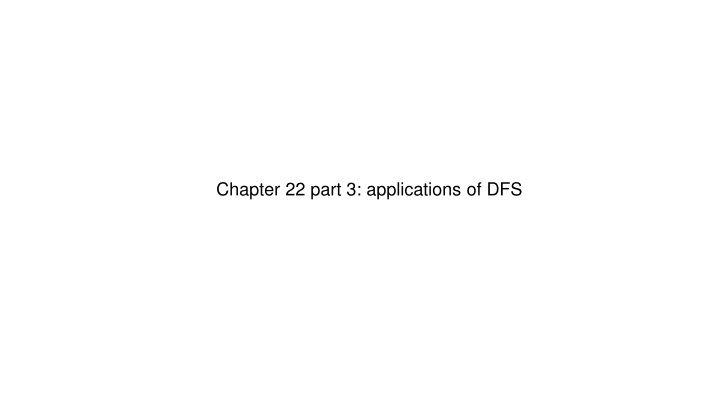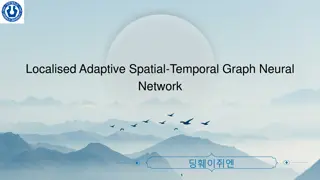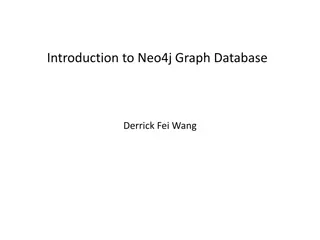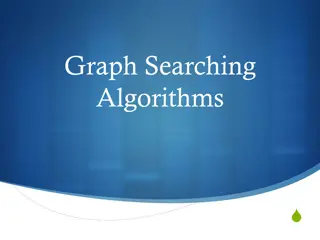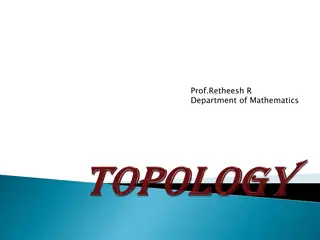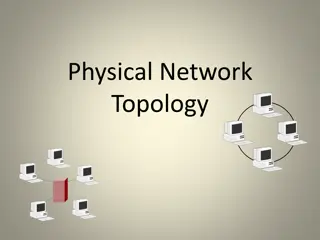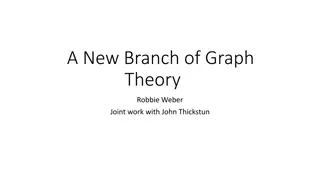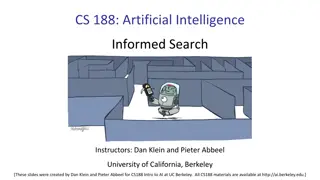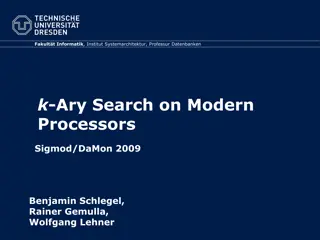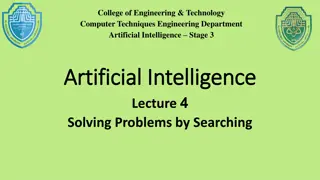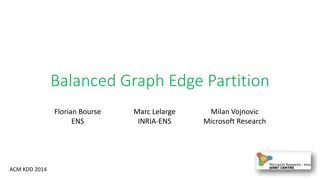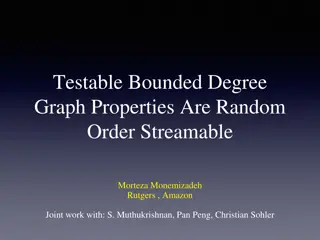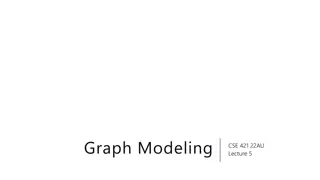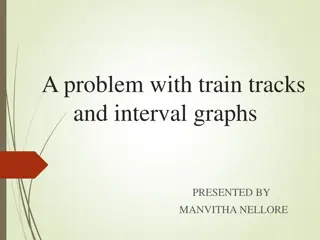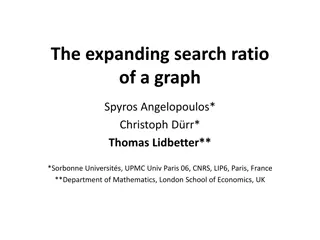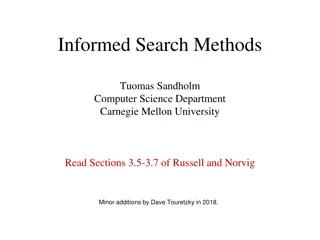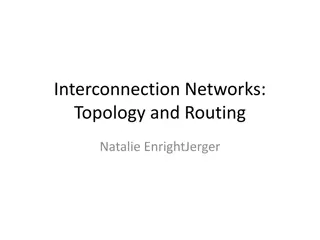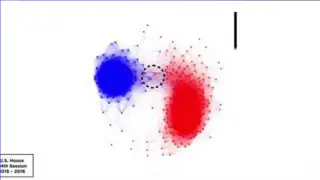Applications of Depth-First Search in Graph Topology
Discover the significance of graph topology and the applications of Depth-First Search (DFS) in laying out data for interpretation. Learn about topological sorting, Directed Acyclic Graphs (DAGs), and the correctness of topological sort.
Download Presentation

Please find below an Image/Link to download the presentation.
The content on the website is provided AS IS for your information and personal use only. It may not be sold, licensed, or shared on other websites without obtaining consent from the author.If you encounter any issues during the download, it is possible that the publisher has removed the file from their server.
You are allowed to download the files provided on this website for personal or commercial use, subject to the condition that they are used lawfully. All files are the property of their respective owners.
The content on the website is provided AS IS for your information and personal use only. It may not be sold, licensed, or shared on other websites without obtaining consent from the author.
E N D
Presentation Transcript
Graph topology: Information content of a graph is connectivity of data. Layout of graph may reflect convenience of drawing or clarity of presentation Topological sort is a layout for interpretation of data. Directed acyclic graph (DAG) is used to show precedence of events . Topological sort: linear ordering of vertices in a DAG such that if G contains edge (u->v), then u appears before v in the ordering of vertices (left to right, for example). Pseudocode for topological sort: Topological-Sort(G) DFS(G) yields f[v] for all vertices At each f[v], insert the vertex into the front of a linked list return list
Example: precedence of events getting dressed Arrows point from earlier to later d[v] and f[v] reflect textbook s order of sources Topological sort is independent of this order
Result of topological sort using textbooks order of choosing sources for DFS: With any order of choosing sources, all edges would still point left-to right Consider a DFS with the following order of sources: watch, socks, shorts, and shirt Do on board
socks under shorts 3/6 7/14 pants 4/5 shoes 8/13 15/18 shirt belt 1/2 9/12 watch tie 16/17 DFS with the following order of sources: watch, socks, shorts, and shirt 10/11 jacket
watch shoes socks pants shorts jacket tie belt shirt 4/5 1/2 16/17 7/14 3/6 8/13 10/11 9/12 15/18 With any order of choosing sources, all edges would still point left-to-right
Theorem 22.12: Proof of the correctness of Topological-Sort(G) When edge (u->v) is explored in the DFS of a DAG, v must be white or black because if v is gray, then (u->v) is a back edge (we would be exploring the adjacency list of v) and DFS of a DAG cannot yield a back edge. If v is white, then v is a descendant of u and f[v] < f[u] (Corollary of the Parenthesis Theorem) If v is black, then f[v] has already been assigned and, since we are still exploring the adj[u], f[v] < f[u]. Thus, for any edge(u->v) in the DAG, f[v] < f[u] in topological sort, v will be on the right of u all edges point to the right
Assignment 18 Ex 22.4-1 text p614 Topo sort on DAG of Fig 22.8 p615 Perform a DFS using alphabetical order to resolve ambiguities in order of discovery of new vertecies and choosing new sources. Mark each vertex with d[v] and f[v]. Make a table of v and f[v] with f[v] in decreasing order.
Strongly Connected Components (SCCs) Strongly connected components (SCCs) of directed graph G(V,E) are a set of vertices VSCC V that form a cycle Component graph GSCC = (VSCC, ESCC) Let C1, C2, ..., Ck denote the SCCs of directed graph G VSCC = {v1, v2, ..., vk} contains a vertex from each SCC ESCC are edges of the component graph that connect the SCCs of G Transpose of directed G(V,E) = GT(V,ET): ET = {(u->v) if (v->u) E} (GT has same vertices a G, but its edges are reversed)
SCC(G) Pseudocode: Call DFS(G) to get f[u] for all vertices Construct the transpose of G Call DFS(GT) with source vertices in order of decreasing f[u] of DFS(G) The vertices of each tree of the DFS(GT) forest are a SCC of G Example Fig.22.9 p616 Do on board
c d b a T T 1/10 2/5 12/15 11/16 B T G B T T B 6/9 7/8 13/14 3/4 T h f g c e a Example: Fig 22.9 p616 d b B B 7/10 8/9 3/4 1/6 T GT T T T T T 11/14 12/13 2/5 15/16 B h f g e
c d b a G G T T 1/10 2/5 12/15 11/16 B T B T T B 6/9 7/8 13/14 3/4 T h f g e SCC
Assignment 19 Ex 22.5-2 text p 620 SCCs on graph in Fig 22.6 p611 Perform DFS Perform a DFS using alphabetical order to resolve ambiguities in order of discovery of new vertecies and choosing new sources. Mark each vertex with d[v] and f[v]. Construct the transpose graph. Find SCCs and draw Gscc 2 most common mistakes in DFS are (1) failure to use alphabetical order to remove abiguity in discovery of vertices and choice of next source, and failure to detect the opportunity to discovery new vertices while beack tracking .
Another example of finding SCCs Do on board
c 1/16 d 8/11 a T F a 9/10 T T B 7/12 B e 2/15 G b T g d e h b c f 3/14 T B T T f 6/13 h 4/5 g c 1/2 d 7/12 a T 6/13 T 8/11 T e 3/16 GT b 5/14 T T T f 9/10 h 4/15 g
Theorems behind the SCC pseudo-code Lemma 22.14 Let C and C be distinct SCCs of directed G(V,E). Let (u,v) E be an edge with u in C and v in C , then f(C) > f(C ) If d(C) < d(C ) true by white path theorem If d(C) > d(C ) true by parenthesis structure Corollary 22.15 Let C and C be distinct SCCs of directed G(V,E). Let (u,v) ETbe an edge with u in C and v in C , then f(C) < f(C )
How Strongly-Connected-Components(G) works: In the DFS of GT, start with a vertex in Cmax, the SCC that has the largest finish time. The search will visit all of the vertices of Cmax but will not find an edge that connects Cmax to any other SCC. If such an edge was found to C , then by Corollary 22.15 of Lemma 22.14f(Cmax) < f(C ), which violates the choice of Cmax as the SCC with the largest finish time As the source of the next DFS in GT, chose a vertex in C , the SCC with f(C ) larger than all other finishing time except those in Cmax. The search will visit all the vertices of C and may find some edges that connect it to Cmax but not to any other SCC. Since the vertices of Cmax have already been discovered, the only new vertices visited from the second source are those in C .
